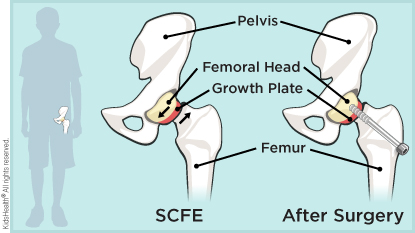In slipped capital femoral epiphysis (SCFE), the very top of the thighbone (called the femoral head) slips out of line with the rest of the thighbone, causing a weakened hip joint. To treat your child's SCFE, the orthopedic surgeon put one or more screws into the top of the thighbone to keep it steady.
You can help your child recover from surgery over the next several weeks. Slowly, your child will return to most activities in a few months.




Your child:

Why do kids get SCFE? Doctors aren't sure why kids get SCFE. It usually affects kids 11 to 16 years old who are going through a growth spurt. The condition is more common in boys, though girls can get it too. Kids with some underlying health problems and those with a higher weight are more likely to get SCFE. Sometimes the condition runs in families.
Do kids with SCFE need more care after surgery? Your child will have checkups with the care team while they're still growing to make sure the hip is doing OK. Usually, kids won't need more surgery on the treated hip. Many kids with SCFE in one hip will get it in the other hip too. So doctors sometimes suggest treating both hips during one surgery. If not, the care team will watch the other hip closely for signs of SCFE.